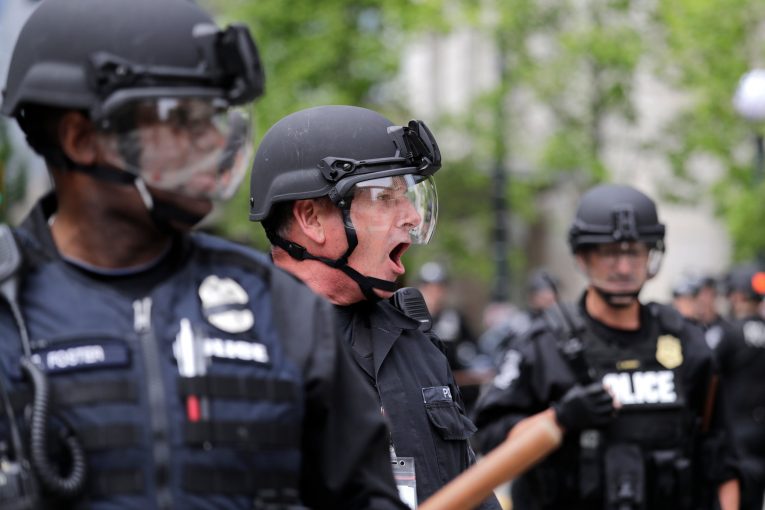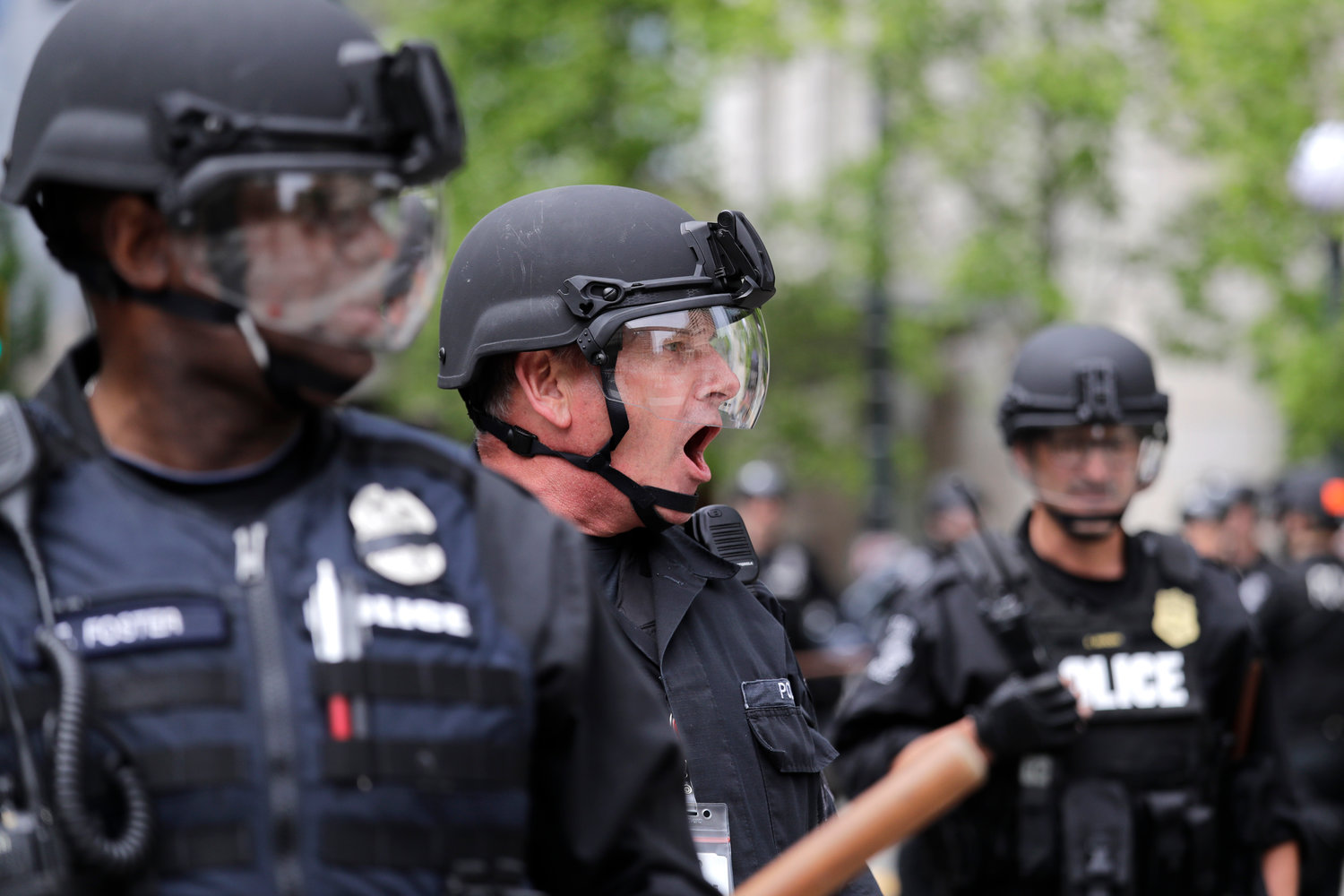

By Tiffany Devlin
SEATTLE – Across the country, since late May, there have been large and noisy demonstrations protesting the police killing of Black men and women by law enforcement, including the murder of George Floyd by a Minneapolis Police Officer.
Since May 30, Seattle’s Office of Police Accountability (OPA) has been contacted 19,000 times about Seattle Police Department’s (SPD) conduct in response to these demonstrations. So far, there are 126 cases.
Seattle’s OPA released five more completed investigations late last week related to alleged police misconduct by SPD during these demonstrations.
While three investigations were not sustained, two were recommended to a sustained finding because of the use of excessive force by police officers in both cases.
The first sustained case took place on June 7, where the complainant alleged that an  officer slammed her head into the ground, using excessive force.
officer slammed her head into the ground, using excessive force.
After viewing video evidence from a witness, the OPA found that the amount of force used to secure the complainant was disproportionate under the circumstances of the case. In the first two seconds of the video, the officer was seen forcibly pushing the complainant into the ground twice, causing her to sustain injuries to her face.
Both the officer and another officer witness stated that the complainant did not resist, which is confirmed by the video footage. There was also a significant weight difference between the officer and the complainant, where the officer weighed 240 pounds and the complainant weighed 125 pounds.
The second sustained case took place on May 29, where numerous complainants alleged that police used excessive force based on video footage of police punching an individual who was on the ground.
Officers were prohibiting demonstrators from going through a street when one individual did not comply. The officers attempted to take the person into custody, however the individual physically resisted. The individual and the officers were struggling on the ground when the individual hit the officers with a water bottle.
Upon the OPA’s review of video evidence, one officer used reasonable force because it was an immediate reaction to the threat. The officer punched the individual twice in the span of two seconds as a response to being hit with the water bottle.
The second officer, however, began to punch the individual six to eight times 2.5 seconds after the water bottle was swung at the first officer. While the officer believed that the use of force was necessary, OPA’s review concluded that the use of force was excessive, inconsistent with policy, and disproportionate to the circumstances.
In one of the cases that was not sustained, the complainant alleged that an officer improperly pointed a firearm at her, and another officer interacted unprofessionally with her.
When the OPA interviewed the complainant, she claimed that the officers started to use CS gas on demonstrators after someone threw a water bottle at them. The officers also had riot gear and gas masks on prior to “anything ‘bad’ happening.” Another witness was interviewed, claiming that the officers were using tear gas and rubber bullets.
While the complainant reported that an SPD officer pointed a firearm at her, the Body Worn Video (BWV) indicated that an officer employed by the Washington State Patrol (WSP) was pointing a rifle used to shoot rubber bullets at the general direction of the crowd that the complainant was within. There was no video footage of an SPD officer pointing a firearm.
The complainant reported unprofessional behavior from officers, however the OPA did not come to the same conclusion upon reviewing the BWV.
The OPA described the complainant as refusing to comply with the dispersal order while also engaging with the officers in a sarcastic manner. The OPA believed that in the midst of a chaotic  situation, it was not unreasonable nor was it unprofessional for the officers to decline engagement with the Compliant.
situation, it was not unreasonable nor was it unprofessional for the officers to decline engagement with the Compliant.
The OPA also stated that since there was no video footage of an SPD officer pointing a firearm, and because they cannot establish whether it was appropriate for the officer to do so in the case that it did happen, the allegation was considered inconclusive.
In another case that was not sustained, the complainant claimed to be falsely arrested, that she was subjected to biased policing, that she was not read any Miranda Warnings, and that she was improperly transported from a police precinct.
While an SPD supervisor was telling demonstrators not to cross the barricade in the vicinity of the East Precinct, the complainant was the only demonstrator who crossed it at the time. Officers arrested her as a result of the barricade crossing, and BWV showed lack of any other force during the arrest.
The complainant claimed that she was being arrested because of her Chinook heritage while also saying she identified as white. She also asked why her Native American rights were being abused, claiming that the officer arresting her was making a biased policing claim.
The complainant was transported to King County Jail via American Medical Response (AMR) after she refused to be transported in a marked SPD van, and due to “concerns about her mental health.” The complainant repeatedly discussed that “officers were harvesting the organs of arrestees” and thought they would do the same to her.
The OPA concluded that the officers had probable cause to arrest the complainant based on her crossing the barricade, not due to her Chinook heritage. Based on the BWV, the complainant’s Miranda Warnings were also read in full to her.
In regards to her transportation via AMR, the OPA stated that the officers were consistent with training and policy dealing with uncooperative detainees who may be in a mental health crisis.
In the last unsustained case, the complainants alleged that one officer abused his discretion by instructing a patrol vehicle to drive behind protesters, including one who was kneeling. The second complainant also alleged that a second officer used excessive force.
The first complainant claimed that he saw an officer waving a patrol vehicle behind two protesters near a barricade, striking them while it drove slowly. He ran into the female protester later on, where she confirmed that she was hit by the patrol vehicle.
The second complainant said that a female officer approached her from the back and pushed her with both hands to the ground. The complainant also saw that a kneeling male was “violently” moved and picked up by his arms and legs. His possessions (water bottle, food, jacket, and bandana) were claimed to have been run over.
Based on a review of the In-Car Video (ICV), it was confirmed that the patrol car did not hit any demonstrators. There was also no indication of an officer described by the first complainant waving the patrol vehicle towards the kneeling male, nor was it conclusive that the kneeling male’s possessions were run over.
The ICV also showed that the second complainant lost her balance and fell to the ground after tripping over the kneeling male’s foot. The kneeling male, seen from the video footage, is seen with his foot outstretched at this time.
The OPA concluded that due to the video evidence from the BWV and the ICV, no excessive force was used in regards to the patrol vehicle hitting demonstrators or towards the second complainant.
The OPA also noted that the first officer did not affirmatively wave the patrol vehicle through the specific location, but rather the patrol vehicle turned the corner and pulled up directly behind the kneeling male. The patrol vehicle was said to have been situated in that location based on how it originally turned.
The OPA did indicate that one of the officers said, “he’s lucky he’s not going to fucking jail” from BWV. The officer, however, did not direct this towards the kneeling male, nor was the comment in the presence of community members. The OPA referred this to the chain of command for counseling and retraining.
Seattle’s OPA is now updating its website dashboard in order to show progress involving demonstration-related complaint investigations every three weeks.
To sign up for our new newsletter – Everyday Injustice – https://tinyurl.com/yyultcf9
Support our work – to become a sustaining at $5 – $10- $25 per month hit the link:




